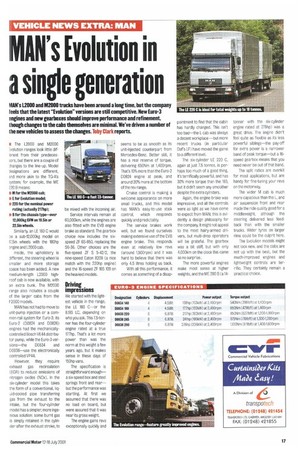MAN's Evolution in a single generation
Page 17

If you've noticed an error in this article please click here to report it so we can fix it.
MAN's L2000 and M2000 trucks have been around a long time, but the company feels that the latest "Evolution" versions are still competitive. New Euro-3 mngines and new gearboxes should improve performance and refinement, though changes to the cabs themselves are minimal. We've driven a number of the new vehicles to assess the changes. Toby Clark reports.
I The L2000 and M2000 'solution ranges look little efferent from their predeces;ors, but there are a couple of :hanges to the line-up. Model iesignations are different, sod more akin to the TG-A's ;ystem; for example, the ME ?.20 B means: ▪ M for the M2000 cab;
D E for Evolution model; D 220 for the nominal power rating (actually 21Thp);
▪ B far the chassis type—over 12,000kgGVW on 19.5in or 22.51n wheels.
Similarly, an LE 180 C would De a sub-12,000kg model on I7.5in wheels with the 180hp rgine and 12000 cab.
Inside, the upholstery is different, the steering wheel is smaller and more storage space has been added. A new medium-length L2000 highroof cab is now available, with an extra bunk. The M2000 range also includes a couple of the larger cabs from the F2000 models.
MAN has not had to move to unit-pump injection or a common-rail system for Euro-3: its Euro-2 (D0824 and 00826) engines had the mechanicallycontrolled Bosch VE44 distributor pump, while the Euro-3 versions—the D0834 and D0836—use the electronically controlled VP44.
However, they require exhaust gas recirculation (EGR) to reduce emissions of nitrogen oxides (N0x). In the six-cylinder model this takes the form of a conventional, liquid-cooled pipe transferring gas from the exhaust to the intake, but the four-cylinder model has a simpler, more ingenious solution: some burnt gas is simply retained in the cylinder after the exhaust stroke, to be mixed with the incoming air.
Service intervals remain at 60,000km, while the engines are also fitted with the EVB engine brake as standard. The gearbox choice now includes the sixspeed ZF 6S-850, replacing the S6-36. Other choices are the five-speed ZF S 5-42/2, the nine-speed Eaton 8209 (a nice match with the 220hp engine) and the 16-speed ZF 16S 109 on the heaviest models.
Driving impressions
We started with the lightest vehicle in the range, the LE 180 C—or the 8.185 LC, depending on who you ask. This 7.5-tonner has the four-cylinder engine rated at a true 177hp. That's a lot more power than was the norm at this weight a few years ago, but it makes sense in these days of 150hp vans.
The specification is straightforward enough— a six-speed box and steel springs front and rear— but the performance was startling. At first we assumed that there was no load on board, but were assured that it was near its gross weight.
The engine gains revs exceptionally quickly and seems to be as smooth as its unit-injected counterpart from Mercedes-Benz. Better still, it has a real reserve of torque, delivering 650Nm at 1,400rpm. That's 10% more than the Euro-2 D0824 engine at peak, and around 20% more at the bottom of the rev range.
Cruise control is making a welcome appearance on more small trucks, and this model has MAN's easy-to-use stalk control, which responds quickly and predictably.
The service brakes work well, but we found ourselves making extensive use of the EVB engine brake. This responds even at relatively low revs (around 1,500rpm) and it was hard to believe that there was only 4.5 litres holding us back.
With all this performance, it comes as something of a disap
pointment to find that the cabin has hardly changed. This isn't too bad—the L cab was always a decent workplace —but more recent trucks (in particular Oaf's LE) have moved the game to a different level.
The six-cylinder LE 220 C, again at just 7.5 tonnes, is perhaps too much of a good thing. It's terrifically powerful, and has 30% more torque than the 480, but it didn't seem any smoother despite the extra cylinders.
Again, the engine brake was impressive, and all the controls were as light as we have come to expect from MAN; this is evidently a design philosophy for the company. It might not appeal to the most hairy-armed drivers, but multi-drop operators will be grateful. The gearbox was a bit stiff, but with only 4,000km on the clock this came as no surprise.
The more powerful engines make most sense at higher weights, and the ME 280 B (a 14
banner with the six-cylinder engine rated at 276hp) was a great drive. The engine didn't feel quite as flexible as its less powerful siblings—the pay-off for extra power is a narrower band of peak torque—but a 16speed gearbox means that you need never be out of that band.
The split ratios are overkill for most applications, but are handy for fine-tuning your revs on the motorway.
The wider M cab is much more capacious than the L, and air suspension front and rear made the ride quality good for a middleweight, although the steering delivered less feedback than with the smaller trucks. Wider tyres on larger rims could be the culprit here.
The Evolution models might not look new, and the cabs arc not up with the best, but the much-improved engines and lightweight controls are terrific. They certainly remain a practical choice.








































































































